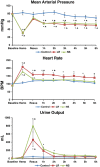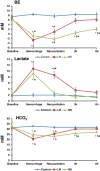Comparisons of normal saline and lactated Ringer's resuscitation on hemodynamics, metabolic responses, and coagulation in pigs after severe hemorrhagic shock
- PMID: 24330733
- PMCID: PMC4029282
- DOI: 10.1186/1757-7241-21-86
Comparisons of normal saline and lactated Ringer's resuscitation on hemodynamics, metabolic responses, and coagulation in pigs after severe hemorrhagic shock
Abstract
Background: Ongoing improvements in trauma care now recommend earlier use of blood products as part of damage control resuscitation, but generally these products are not available at far forward battlefield locations. For the military, questions continue to arise regarding efficacy of normal saline (NS) vs. lactated Ringer's (LR). Thus, this study compared the effects of LR and NS after severe hemorrhage in pigs.
Methods: 20 anesthetized pigs were randomized into control (n = 6), LR (n = 7), and NS (n = 7) groups. Hemorrhage of 60% estimated total blood volume was induced in LR and NS groups by removing blood from the left femoral artery using a computer-controlled pump. Afterwards, the pigs were resuscitated with either LR at 3 times the bled volume or the volume of NS to reach the same mean arterial pressure (MAP) as in LR group. Hemodynamics were measured hourly and blood samples were taken at baseline (BL), 15 min, 3 h and 6 h after resuscitation to measure changes in coagulation using thrombelastograph®.
Results: MAP was decreased by hemorrhage but returned to BL within 1 h after resuscitation with LR (119 ± 7 ml/kg) or NS (183 ± 9 ml/kg, p < 0.05). Base excess (BE) was decreased by hemorrhage; resuscitation with LR recovered BE but not with NS. Total peripheral resistance was decreased with NS and LR, with a larger drop shown in NS. Serum potassium was increased with NS, but not affected with LR. Coagulation changes were similar between LR and NS.
Conclusions: NS may be inferior to LR in resuscitation due to its vasodilator effects and the risks of metabolic acidosis and hyperkalemia.
Figures





Similar articles
-
Lactated ringer's is superior to normal saline in a model of massive hemorrhage and resuscitation.J Trauma. 1998 Nov;45(5):894-9. doi: 10.1097/00005373-199811000-00010. J Trauma. 1998. PMID: 9820700
-
Differential changes in hepatic synthesis of albumin and fibrinogen after severe hemorrhagic shock in pigs.Shock. 2014 Jan;41(1):67-71. doi: 10.1097/SHK.0000000000000071. Shock. 2014. PMID: 24351528
-
Resuscitation of haemorrhagic shock with normal saline vs. lactated Ringer's: effects on oxygenation, extravascular lung water and haemodynamics.Crit Care. 2009;13(2):R30. doi: 10.1186/cc7736. Epub 2009 Mar 4. Crit Care. 2009. PMID: 19257901 Free PMC article.
-
Lactated Ringer's solution versus saline fluid resuscitation for reducing progression to moderate-to-severe acute pancreatitis: a systematic review and meta-analysis.Int J Surg. 2025 May 1;111(5):3467-3480. doi: 10.1097/JS9.0000000000002330. Int J Surg. 2025. PMID: 40085761 Free PMC article.
-
Lactated Ringer's vs normal saline for acute pancreatitis: An updated systematic review and meta-analysis.Pancreatology. 2021 Oct;21(7):1217-1223. doi: 10.1016/j.pan.2021.06.002. Epub 2021 Jun 18. Pancreatology. 2021. PMID: 34172360
Cited by
-
Strategies for Intravenous Fluid Resuscitation in Trauma Patients.World J Surg. 2017 May;41(5):1170-1183. doi: 10.1007/s00268-016-3865-7. World J Surg. 2017. PMID: 28058475 Free PMC article. Review.
-
Effects of Different Crystalloid Fluids on Renal Tissue in an Experimental Model of Hemorrhagic Shock.Turk J Anaesthesiol Reanim. 2023 Oct 24;51(5):380-387. doi: 10.4274/TJAR.2023.231262. Turk J Anaesthesiol Reanim. 2023. PMID: 37876163 Free PMC article.
-
Predictive Factors of Outcome in Cases of Out-of-hospital Cardiac Arrest Due to Traffic Accident Injuries in Thailand; a National Database Study.Arch Acad Emerg Med. 2022 Aug 16;10(1):e64. doi: 10.22037/aaem.v10i1.1700. eCollection 2022. Arch Acad Emerg Med. 2022. PMID: 36381974 Free PMC article.
-
Crystalloid and Colloid Compositions and Their Impact.Front Vet Sci. 2021 Mar 31;8:639848. doi: 10.3389/fvets.2021.639848. eCollection 2021. Front Vet Sci. 2021. PMID: 33869319 Free PMC article. Review.
-
Balanced crystalloids for septic shock resuscitation.Rev Bras Ter Intensiva. 2016 Oct-Dec;28(4):463-471. doi: 10.5935/0103-507X.20160079. Rev Bras Ter Intensiva. 2016. PMID: 28099643 Free PMC article. Review.
References
-
- Mullins RJ. Management of Shock. Philadelphia, Stamford, CT: Appleton & Lange; 1996.
-
- Maier RV. In: Surgery:Scientific Principles and Practice. 2. Greenfield LJ, Mulholland MW, Oldham KT, Zelenock GB, Lillemoe KD, editor. Philadelphia, PA: Lippincott-Raven; 1997. Shock; pp. 182–215.
-
- Carlino W. Damage control resuscitation from major haemorrhage in polytrauma. Eur J Orthop Surg Traumatol. 2013. [Epub ahead of print] - PubMed
Publication types
MeSH terms
Substances
LinkOut - more resources
Full Text Sources
Other Literature Sources
Medical
Miscellaneous

